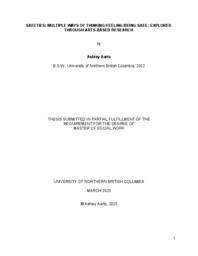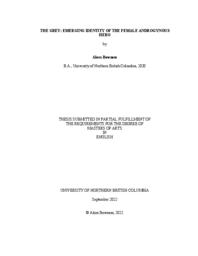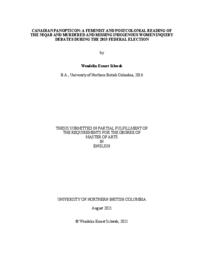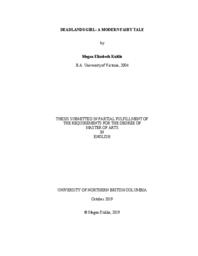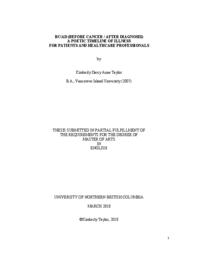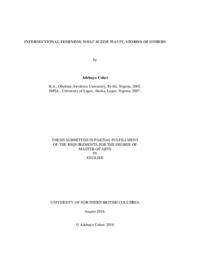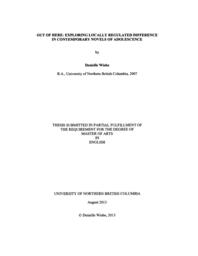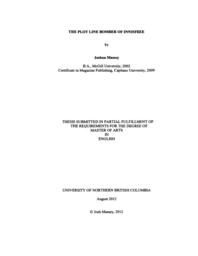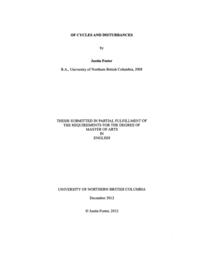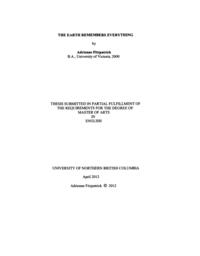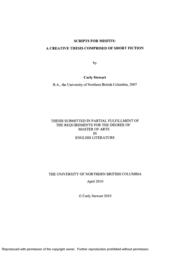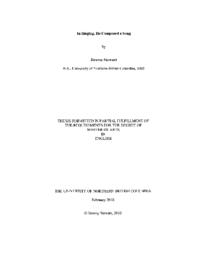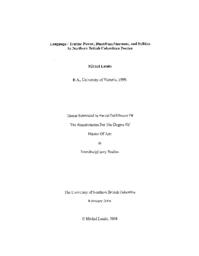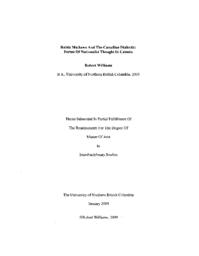Budde, Robert
Person Preferred Name
Robert Budde
Related Works
Content type
Digital Document
Origin Information
Content type
Digital Document
Origin Information
Content type
Digital Document
Description / Synopsis
The Marshmallow Effect is a fictional work that explores the consequences of isolation and trauma on an individual’s identity. The story revolves around the protagonist Arthur, a man who inadvertently creates a reality-bending psychological safe haven to protect himself from his past only to have it warp and transform into an insidious space which forces him to confront said past. This project, written as a screenplay, follows Arthur as he experiences and is affected by horrifically warped versions of his memories, unbound by the rules of reality and fantastical in their proportions, until he becomes an active participant and takes back control of his space and identity. Through discussions of horror, ghosts, folklore, film, and psychological critique, my introduction breaks down the application of setting in the story as a transformative, trauma-informed space that is inexorably intertwined with Arthur’s identity and body, the relationship between the characters and repetition of action to initially reinforce, then defamiliarize, identity, and the difficulties in confronting or coming to terms with trauma in order to move past negativity and into a realm of greater stability in terms of the self and identity.
Origin Information
Content type
Digital Document
Description / Synopsis
Theorists who study the formulation of the hero have identified that the appearance of the hero varies depending on the time and place they are needed. Yet, the function of hero archetypes, such as Joseph Campbell’s monomyth, have reinforced traditional Caucasian masculine male mythic ideologies in young-adult fiction. Reconfiguring the idea of the hero to question its masculine bias and include a female androgynous heroic paradigm will expand the limited classification of “hero” as the hero is encouraged to hone both her masculinity and femininity. This project focuses on a hero with both an androgynous personality and an Indigenous heritage. These aspects of my project push back against the gender and cultural norms often associated with heroic journeys in Western culture. Throughout this thesis, I formulate a more accepting form of identity by mapping an encompassing version of the hero’s journey that pushes the boundaries of classic “heroism” but still utilizes the familiar and effective pattern of the heroic journey of the self by comfortably living in the what I am titling “grey space”. By illustrating the fluidity of identity, young readers can relate to a heroic character who encompasses more than the traditional role outlined by Campbell.
Origin Information
Content type
Digital Document
Description / Synopsis
Simon’s Song is a self-reflexive creative-critical text composed of journal entries, research notes, and various other records written by fictional undergraduate student Simon Goodsworth, and compiled by an anonymous archivist. Through the organized presentation of Simon’s writings, there appears a fragmented narrative which follows Simon as he joins his university’s musical theatre club and becomes absorbed in planning and research for a Master’s thesis applying poststructuralist theory to the study of musical theatre. Simon’s research and original insights into the work of Roland Barthes, Jacques Derrida, Martin Heidegger, and Gilles Deleuze and Felix Guattari destabilize the hidden structures implicit in his perception of his self and his world. Through his writing Simon stages explorations of the ubiquity of performativity, the relationship between life and writing, and the inescapability of what Derrida calls “différance,” the precondition of language and meaning in general. Implicit in Simon’s Song is a recognition that each act of engagement with this text is an uniterable performance. Were it not for this recognition of provisionality, it would be safe to assert that Simon’s Song is, above anything else, a thesis about itself.
Origin Information
Content type
Digital Document
Description / Synopsis
Canada is a settler-colonial state that specially targets and others minority groups, such as Indigenous peoples and recent immigrants. This was no more apparent than during the 2015 federal election, which saw debates on whether to ban Muslim women from wearing niqabs and other head coverings and whether to hold an inquiry into the epidemic of missing and murdered Indigenous women. By examining excerpts from speeches, tweets, articles, and interviews made by politicians, citizens, and journalists, this thesis traces the shape of settler-colonial systems and their impact on Indigenous and immigrant women. Canadian society demands conformity to sexual and cultural norms that require walking a tightrope of these double-edged ideals. Conformity is maintained through societally enforced regimes, known as the Panopticon, where each individual is both prisoner and guard. This constant surveillance does not simply end there, however, as Canadian settler society has different gender structures and norms for both men and women: women are subject to far stricter social expectations than men and, as this thesis brings to light, women in minority groups, such as indigenous and Muslim women, fall under an even harsher Canadian spotlight.
Origin Information
Content type
Digital Document
Description / Synopsis
In this thesis I draw on deconstruction theory and queer theory to analyze the current representation of sex, gender, and sexuality in Canadian television. Through this research I found that although Canadian television is portraying an increasing number of queer genders and sexualities, misinformation and stereotypes continue to perpetuate a one-dimensional characterization of people. This research pertains directly to my creative thesis: a pilot episode of a TV series which fraternal twins, Jed and Theodora, grow up with the ability to switch into one another's body. I dive directly into the correlation between sex and gender and the lived experience of being in a body that does not necessarily represent gender. The will both create a new gendered "construction" as well as question the need for gender identifications.
Origin Information
Content type
Digital Document
Description / Synopsis
In literature and film, werewolves have gone through an incredibly varied series of portrayals, but, throughout all of their changes (cycling largely between being antagonists and protagonists), werewolves have always interacted with the essentialist concept of the human-animal binary. Mutable at their core, werewolves reflect the people, places, and times of their various manifestations; the werewolf is whatever we need it to be. The fact that werewolves are inherently liminal creatures means that, for the purposes of my thesis' discussion, werewolves can serve as a tool for addressing preconceived notions of human exceptionalism (i.e., anthropocentrism). I question the assumptions of boundaries and socalled human traits with a story about embracing the uncertainty that our classifications and labels seek to efface. Simultaneously, I draw attention to female werewolves to level a concurrent challenge against patriarchal scripts that denigrate the association of human females with non-human animals. Just as many historical portrayals of werewolves reinforce the negative connotations of a woman-animal alignment, so too do contemporary representations of female werewolves become subject to portrayals that reinforce patriarchal values, rather than challenge them. Therefore, my focus is two-fold: to present an alternative narrative (in the form of a theory piece married to a novel) that draws attention to the artificial nature of both anthropocentrism and androcentrism. These two ways of thinking—that humans are inherently more important than animals and that the perspectives of male humans, in particular, trump all other points of view—are inextricably linked in their ideological othering of alternative experiences of being. The female werewolf, an embodiment of both inferior entities, is a well-suited symbol to decentralize dominant patriarchal narratives. Presented herein is my theory piece and the first fifteen chapters of my novel, Then, We Were Wolves, Again. It is a story about a woman who becomes the wolf she was all along and a man who undergoes a transformation but does not change. As a human, the protagonist, Harley, drifted through life like a lone wolf, but now, as an actual werewolf, she struggles to reconcile her instinctual need for her pack with her growing sense of disenchantment with her fellow lycanthropes. Indoctrinated by their leader, Arden, they're convinced of their sovereignty as a superior species to humans, but this new werewolf picks away at the cracks of hypocrisy, revealing the same species-centric thinking the wolves claim to transcend.
Origin Information
Content type
Digital Document
Description / Synopsis
Exploring the experiences of people who build a casket for a loved one is not clearly delineated in academic literature. This study focused on identifying and sharing the experiences of people who engaged in casket building for a loved one. The purpose of the research was to explore and interpret people’s experiences with casket building. Using an interpretive description approach and thematic data analysis, my research encompassed the experiences of four people who engaged in casket building for a loved one. Ultimately, four themes were generated: 1) A Desire for Something Different, 2) Influential Death Rituals, 3) The Importance of Relationships, and 4) Maintaining Wellness. The research supports those who may choose to follow in their footsteps. The study also encourages social workers to utilize practices, which some may consider non-traditional, to best meet the needs of the populations they serve.
Origin Information
Content type
Digital Document
Description / Synopsis
Deadlands Girl is a short young adult, fantasy fiction novel set in a post-apocalyptic Canada. The protagonist, Tabitha, is kidnapped and brought to Faerie and the novel follows her quest to come back home. Written as a response to the notion that there are few non-historical Young Adult (YA) novels that are set in Canada, my creative thesis demonstrates that a novel can explore themes of identity, belonging and power while using the Canadian landscape as a backdrop and an inspiration. Mythological creatures assist Tabitha on her hero-quest but, ultimately, it is a coming-of-age story about a young woman growing up and discovering her own power. The novel is introduced with a critical analysis of young adult fiction in Canada, a discussion of identity and what it means to be a Canadian writer creating dark, but hopeful, stories for youth.
Origin Information
Content type
Digital Document
Description / Synopsis
Divisive political discourse today reflects a need to address issues of oppression in North American society. Accordingly, teachers can help students confront these problems. Linking critical pedagogy and transformative learning theory, this interdisciplinary research examines whether reading and discussing March Book Two, a historical nonfiction graphic narrative written by civil rights activist John Lewis and Andrew Aydin, led students in a British Columbian Adult Basic Education English class to transform their perspectives on social-justice related issues. Qualitative data were collected from student work, classroom observations, and post-semester interviews in an instructor-led action research case study.
Origin Information
Content type
Digital Document
Origin Information
Content type
Digital Document
Origin Information
Content type
Digital Document
Origin Information
Content type
Digital Document
Origin Information
Content type
Digital Document
Origin Information
Content type
Digital Document
Origin Information
Content type
Digital Document
Origin Information
Content type
Digital Document
Origin Information
Content type
Digital Document
Origin Information
Content type
Digital Document
Origin Information

